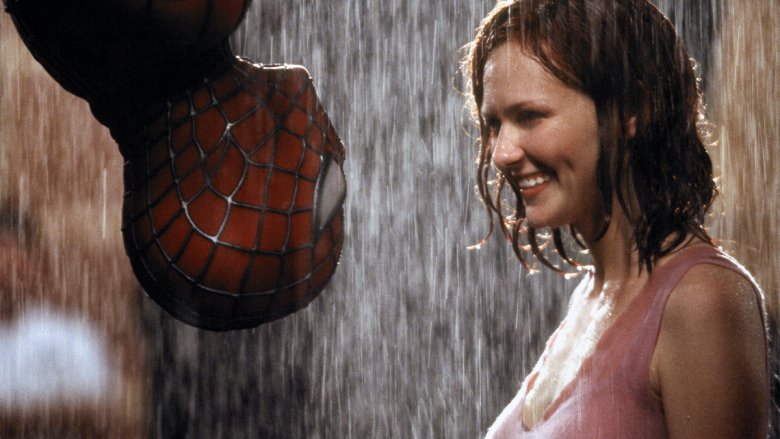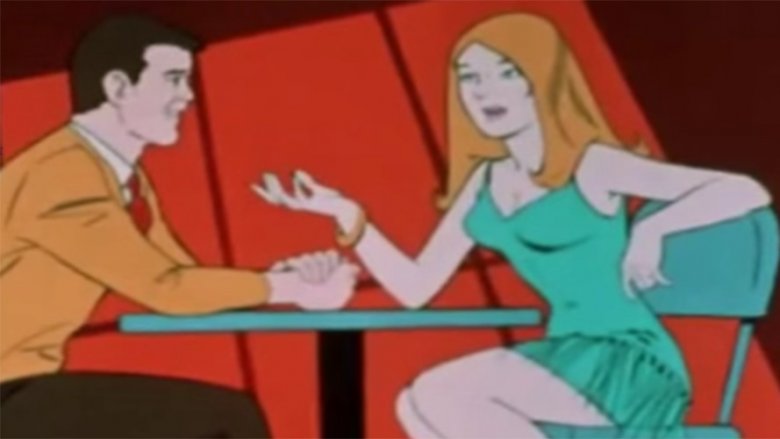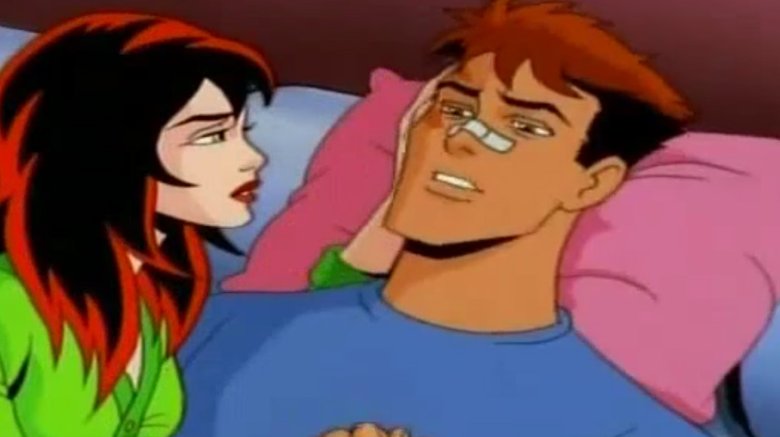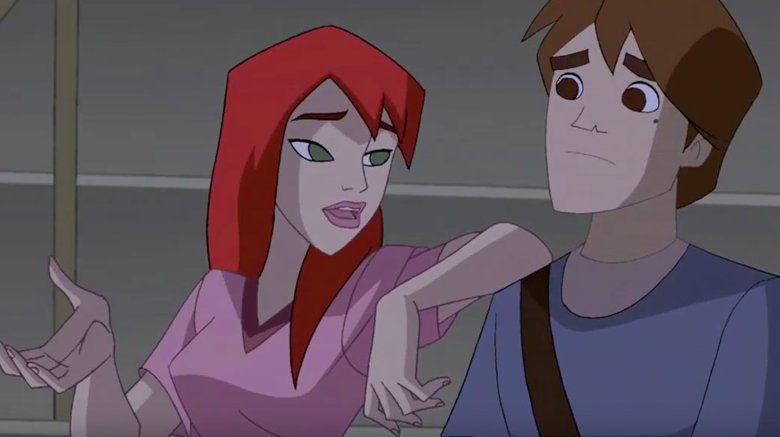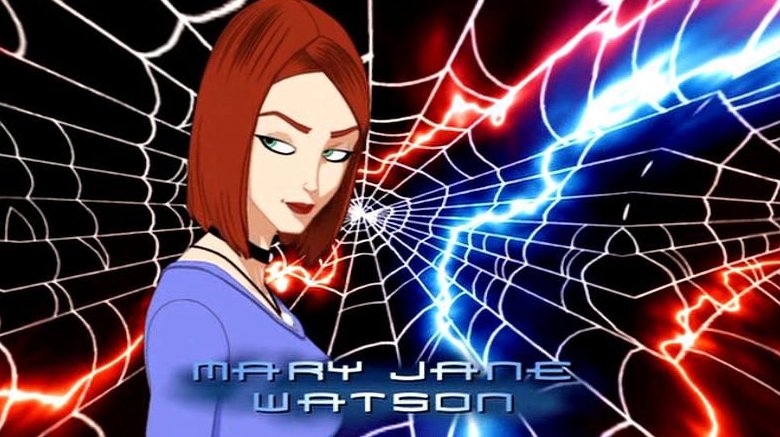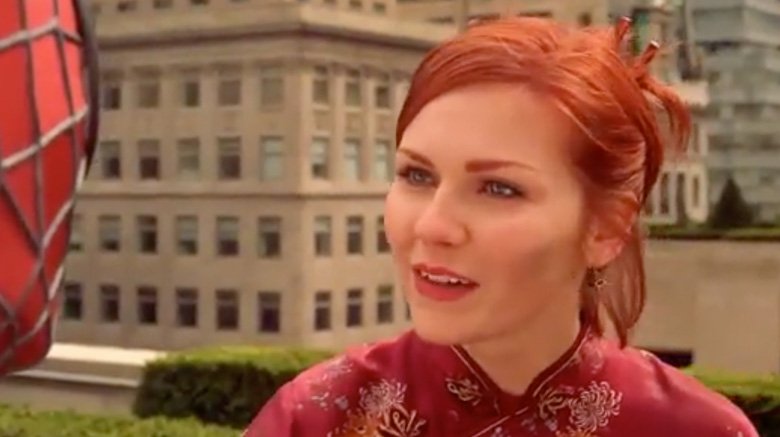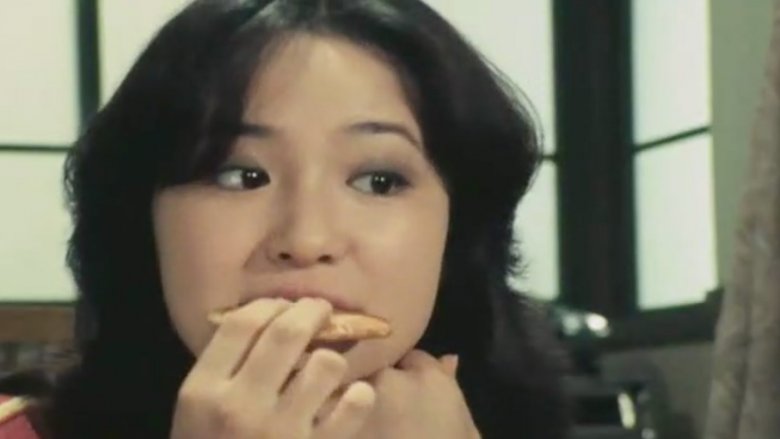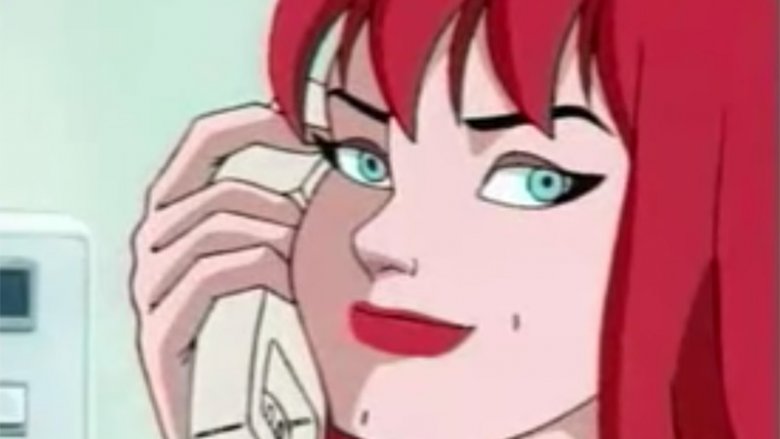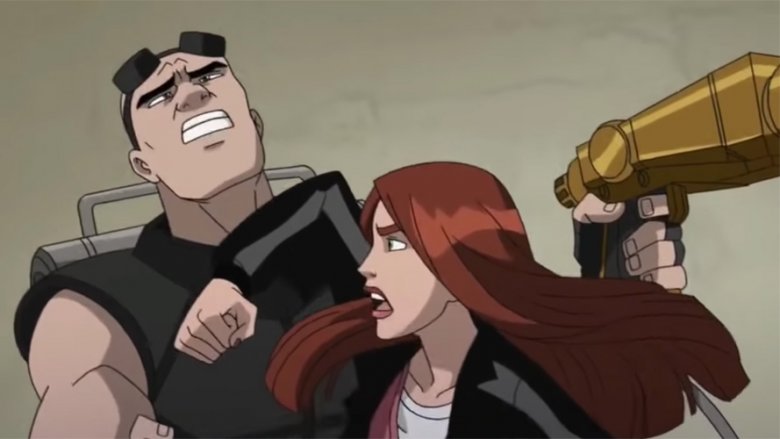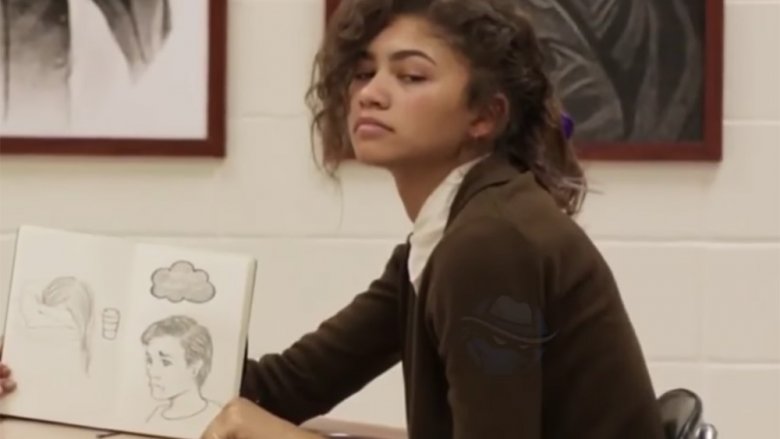Every Version Of Mary Jane Ranked From Worst To Best
Face it, tiger: Marvel Comics hit the jackpot in 1966 when they introduced Mary Jane Watson to the Spider-Man mythos. Originally portrayed as a flighty party girl who formed the final corner of Peter Parker's first love triangle, MJ evolved over the years into a complicated and compelling character, and arguably the greatest love of Spidey's life. They'd even get married at one point — although that would end thanks to the intervention of the devil, because comic books are complicated.
Either way, Mary Jane's long-lasting prominence in the comics means that she's also been featured in almost every Spider-Man adaptation. From the big screen to Saturday morning cartoons, there's a whole roster of MJs that might just be even more different from each other than their corresponding Spideys. From obscure cameos all the way to the modern-day Marvel Cinematic Universe, here's every version of Mary Jane Watson ranked from worst to best!
Peg Dixon (Spider-Man '67)
Mary Jane's appearance on the first Spider-Man cartoon — you know, the one with the great theme song that all the memes are from? — isn't really bad. Like every other thing that happened on this show for its entire 52-episode run, it's just sort of inexplicable.
While she has the name "Mary Jane," this version is more of a mashup of MJ and Gwen Stacy, to the point where she's portrayed as Captain George Stacy's niece. That raises the question of why they went with MJ instead of just sliding Gwen into the role in the first place. Both characters are, after all, in the story that was lifted from Amazing Spider-Man #59 for her one and only appearance on the show, although to be fair, MJ's definitely in the lead role in that one.
Either way, it's not terrible, at least by the standards of the rest of the not-very-good show around her. That said, it's pretty weird that one of the major characters of the entire Spider-Man saga makes her only appearance in the entire series in a story about how she gets duped into go-go dancing at a club frequented by city officials so that the Kingpin can brainwash them with a mind control machine. Ah, the '60s.
Jennifer Hale (Spider-Man Unlimited)
If you're not familiar with it, and you honestly have no reason to be, the one thing you need to know about Spider-Man Unlimited is that it's relentlessly weird on every level.
After Fox's popular Spider-Man animated series ended in 1998, someone had the idea to reboot the show in a way that could be seen as a continuation of what had already been done, but would keep viewers interested by avoiding everything they'd already seen over the past four years. With that in mind, they launched a new series with the truly buck wild premise of Spider-Man following Venom, Carnage, and hero astronaut and occasional werewolf John Jameson to an alternate version of Earth on the other side of the sun that was populated mostly by human-animal hybrids created by the High Evolutionary. Oh, and instead of just his usual spider powers, Spidey had a brand new nano-tech suit with built-in robot weapons. Needless to say, it only lasted a season.
By necessity, that premise meant leaving most of Spidey's established continuity behind, including J. Jonah Jameson, the Daily Bugle, and a Manhattan that was not ruled over by a tiger-man. As a result, Mary Jane only appears briefly in the first episode, giving Peter the helpful advice that he should fake his death so he doesn't have to be Spider-Man anymore. It's not much of a role, and what little there is involves literally telling Spider-Man to stop being a superhero, but Jennifer Hale does a solid job with the few moments she has. Fortunately, as anyone who played Mass Effect knows, she'd go on to much better things after.
Vanessa Marshall (Spectacular Spider-Man)
The major use of Mary Jane that we see in the short-lived, 26-episode Spectacular Spider-Man series comes when the show commits hard to the bit about Peter Parker not wanting to meet her because of Aunt May's description of her as having "a wonderful personality." It's an updating of and a twist on the joke that accompanied the character in her earliest comics appearances, but here, it just lands flat.
For one thing, Peter physically shudders at the thought of meeting a girl that he might not find attractive, which makes him seem like a huge jerk. That in itself isn't a bad thing, as Peter's default state is that he has to learn not to be a jerk over and over, occasionally through a dead uncle. This time, though, there's no real lesson. Mary Jane's arrival is played out as teaching him not to judge people by their appearances, but that you never know when someone might turn out to be hot, so you should only shudder in response to someone if you already know they're not attractive. Not quite as solid a moral lesson as the thing about power and responsibility.
For her part, Vanessa Marshall blends what worked best about her predecessors, tempering Sara Ballentine's over the top, soap operatic emoting with more of Lisa Loeb's laconic breathiness. It's just unfortunate that she's never really used to her full potential.
Lisa Loeb (Spider-Man: The New Animated Series)
Spider-Man: The New Animated Series was a weird little experiment for a lot of reasons. Most obviously, it had a computer-animated style that definitely stood out in 2003, but was full of jerky motion that never quite worked for the web-slinging action that was important for the show. For another, stocking the cast of a Spider-Man series with a cast of musicians and teenage heartthrobs like Ian Ziering and James Marsters was a great choice for a show that was going to air on MTV with a goal of attracting an older audience that might've thought they'd grown out of the previous animated series.
Which is how we got Lisa Loeb, best known for the hit single "Stay (I Missed You)," stepping into the role of Mary Jane Watson. She was a solid choice, bringing an entirely different sort of character than we'd ever seen before with MJ. Unfortunately, it's also early enough in her non-musical career that her acting isn't quite there yet, and the janky animation just exacerbates some stilted dialogue. To make matters worse, this is a version of Mary Jane that, despite what we're told by the show, has absolutely zero chemistry with Spider-Man — although that probably has less to do with MJ than with the cartoonish Big Bad Wolf voice that Neil Patrick Harris puts on to disguise his version of Spidey from Peter Parker's friends.
Kirsten Dunst (Spider-Man, Spider-Man 2, Spider-Man 3)
The Mary Jane we see in Sam Raimi's cinematic Spider-Man trilogy is a study in extremes. She appears in all three movies as the primary love interest, to varying degrees of success. The third film flirts with throwing Gwen Stacy into the mix, but she's really just there as a prop for Peter and MJ's relationship, to make Mary Jane seethe with jealousy.
And that's sort of the problem. Throughout the films, Mary Jane's understandable frustrations with Peter are taken to extremes, and presented to us as a callous misunderstanding of the burden Peter has to bear as Spider-Man. That's not entirely her fault as a character, though; Peter deciding not to tell her his identity at the end of the first movie is an almost inexplicable choice given their history, and without that knowledge, his flakiness is downright infuriating. To make matters worse, she's kidnapped by supervillains in all three movies, and while that might be the default role of a superhero's love interest, it gets repetitive.
With all that said, though, Raimi trilogy's MJ really does have a lot of great moments to go along with the bad ones, including the upside-down kiss in the rain that stands as one of the most iconic superhero movie moments of the 2000s.
Rika Miura (Supaidaman)
Toei's 1978 adaptation of Spider-Man as a Japanese tokusatsu show — often called Supaidaman to distinguish it from its American inspiration — didn't exactly line up with its source material. Instead of high school student Peter Parker being bitten by a radioactive spider, for instance, dirt-bike racing champion Takuya Yamashiro was granted fantastic wall-crawling powers by a dying alien, which included both web-shooters and a 50-foot sword-wielding robot named Leopardon. Also, instead of super-villains like the Green Goblin and Doctor Octopus, he spends his time fighting "Machine BEMs" created by a cyborg named Professor Monster.
With that in mind, it shouldn't be surprising that Takuya's love interest, Hitomi Sakuma, is pretty different from her American counterpart. While Mary Jane was a model and actress by the '70s, Hitomi is actually a little closer to Peter Parker. She's an intrepid photojournalist working for a character that bears more than a passing resemblance to J. Jonah Jameson. The only big differences are that Japan's JJJ is actually Amazoness, the field commander of the evil Iron Cross Army, and that since Hitomi's actually taking pictures of Spider-Man rather than just selling off some extremely marketable selfies, it turns out she's a better photojournalist than Peter, too.
Between Spider-Man having a giant robot and J. Jonah Jameson also being Rita Repulsa, it should be clear at this point that basically everything about Supaidaman rules, and Hitomi is no exception.
Sara Ballentine (Spider-Man '94)
By the time Spider-Man hit the airwaves in 1994, the standard had been set pretty high. Two years earlier, we'd seen the debut of both Batman: The Animated Series, arguably the best version of the Dark Knight in any medium, and X-Men, the cartoon that introduced millions of viewers to Marvel's merry mutants at the height of their popularity, kicking off a genuine golden age of superhero cartoons. Still, while it might not have hit the high points of BTAS or had the memorable theme song of X-Men — instead going with a truly bizarre techno song about spider blood — there's an entire generation with some fond memories of this version of Spider-Man.
Much like the rest of the show, Spider-Man's Mary Jane was a pretty accurate translation of the character as seen in the comics, with all the good and bad that went along with it. Overall, though, she was a great foil for Peter Parker (and a great corner of the love triangle with the Black Cat), and Sara Ballentine would find her way into a lot of Spidey readers' heads as the default voice of the character.
At the same time, she's not perfect. If nothing else, the idea that a person who was even remotely interested in fashion would be walking around New York City in the mid-'90s in a poofy yellow sweater, lavender jeans, and cowboy boots is even less believable than a dude getting super-strength from a radioactive spider-bite.
Tara Strong (Ultimate Spider-Man)
With roles on The Powerpuff Girls, My Little Pony: Friendship is Magic, Teen Titans Go!, and a litany of other animated projects, Tara Strong is one of the most prolific and prominent voice actresses of the 21st century. The fact that she spent four years playing Mary Jane Watson and did an incredibly solid job of it is one of those things that's only surprising when you realize she hadn't done it already.
But beyond Strong's usual great performance, Ultimate Spider-Man's Mary Jane is one of the most interesting and engaging takes on the character that's ever made its way to popular media, and the reasons are simple. While she has all the trappings of the classic MJ, this version distinguishes itself from the others by looking to another source for inspiration: Lois Lane. Recasting MJ as an aspiring reporter who's eager to land a job with J. Jonah Jameson gives her interactions with Peter (and Spider-Man) an entirely different feeling. Plus, shifting the day job aspect of the character onto MJ allowed this version of Spider-Man to dive into ongoing plots being recruited by S.H.I.E.L.D., leading a team of teenage heroes, and even having cross-dimensional team-ups with heroes from throughout the Spider-Verse.
It's easy to write that off as a narrative convenience, but it really does build a foundation that allows Mary Jane to be a lot more than she was in previous takes. Ultimate Spider-Man might not get the attention that other Spidey projects have in the past, but it's a real hidden gem, and MJ is a huge part of what makes it work.
Zendaya (Spider-Man: Homecoming)
If you want to get technical about it, Zendaya doesn't actually play "Mary Jane" in 2017's amazing and spectacular Spider-Man: Homecoming. Instead, she plays a character named Michelle, whose last name — Jones — and the fact that she goes by "MJ" around friends were kept from moviegoers until the movie's final moments, playing on the fact that we all know what those particular initials mean in the context of a Spider-Man story. The awkward "gotcha" moment of that reveal might actually be the worst part of the film, although if that's the one thing we really have to complain about, that should tell you how great the movie is.
The reason the reveal works at all is that we have no real reason to expect that Michelle is going to turn out to be this character that we already know. Her personality and characterization are completely different from what we've come to expect from Mary Jane Watson, with a bored, sardonic attitude replacing the smiling popularity that we'd all expect. But here's the thing: that's what makes her the perfect MJ.
Mary Jane has always been about subverting expectations. Her first appearance in the comic was built on the idea that Peter had been intentionally ducking out on meeting this girl that his aunt was trying to set him up with for months, only to find out that she was actually great. After Gwen Stacy's death, she was finally revealed to have a personality that ran a lot deeper than the party girl she was portrayed as. Most importantly, the reveal that she'd known Peter's secret identity since before she actually met him — something hinted at in the way Zendaya's MJ looks at Peter at the end of the movie — redefined the core of her character. Homecoming's version might be called Michelle Jones, but it turns out that a Mary Jane by any other name can be every bit as good as the others.
